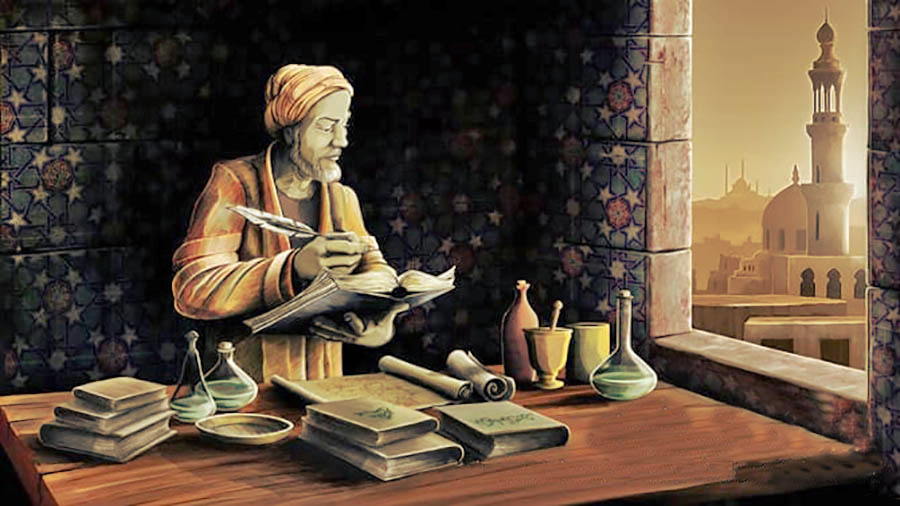Sun 19 April 2020:
As the coronavirus strangleholds the world, we look back in time, into Ibn Sina’s scientific discoveries.
With expertise in many fields, from medicine and astronomy to mathematics and theology, Ibn Sina was a Muslim polymath and the father of early modern medicine. Also known as Avicenna in the West, he was a great scientific mind who played a groundbreaking role in curbing the most-feared contagions a thousand years ago.
At a time when the modern world is grappling with the coronavirus pandemic, the first step the World Health Organisation (WHO) took towards flattening the curve of coronavirus positive infections was to insist on deploying the method of quarantine, which was invented by Ibn Sina to tackle the outbursts of human-to-human transmission of disease.
In his masterpiece, ‘The Canon of Medicine’, which was published in 1025, Ibn Sina argued that a 40-day period of quarantine was essential to weaken the spread of contagious infections.
In later years and right up until today, Ibn Sina’s ‘The Canon of Medicine’ has become the cornerstone of modern medicine, so much so that the global medical community used it as the main lecture book for almost 600 years. The Muslim polymath gave inspiration to medieval and modern-day scientists and in different eras they bestowed him with names such as the Galen of Islam, The Prince and Chief of Physicians, The Teacher Second Only to Aristotle, and The Aristotle of Arabs.
Of the 450 works Ibn Sina is believed to have written, 240 have survived. At least 40 of his manuscripts are about medicine. Besides ‘The Canon of Medicine’, his second masterpiece is ‘The Book of Healing’, which is considered to be the largest encyclopedia written by one man, a magnum opus on science, religion and philosophy.
Ibn Sina was first to discover that germs caused diseases, explained the reasons and the processes of how humans develop jaundice and serious bacterial infections like charbon. He used the technique of sedation while curing some life-threatening interior diseases. He also invented the method of diagnosing diabetes by measuring sugar rate in urine samples. Despite his awe-inspiring healing skills, many historians say he never charged for his medical services.
The origin
Born in a village in modern-day Uzbekistan in the summer of 980 AD, Abu Ali Husayn Ibn Sina grew up in a prosperous family. His father was a famous governor and scholar in the region. Ibn Sina received extensive education in the field of science and philosophy. He was known for his astounding memory and intelligence.
At the age of 10, he memorised the Holy Quran. Soon after he began studying Aristotle’s works, drawing him deep into philosophy. While Ibn Sina agreed with Aristotle’s discovery of atoms, he also found a major flaw in it. Ibn Sina argued that an atom cannot be static, that it can also be divided into many subatoms to the point of it becoming non-existent. His strong grasp of mathematics helped him counter Aristotle’s atomic theory.
At 16, Ibn Sina veered towards medicine and in the following two years, he became a physician. He said understanding medicine was not a difficult task for a trained mathematician.
After becoming a physician, his contribution to subjects such as systemic circulation and microcirculation is significant as he separated the two thoughts, which eventually led him to conclude that germs are the main carriers of disease, the fact which a 1,000 years later guided Louis Pasteur’s germ theory.
Ibn Sina’s ‘The Canon of Medicine’ played a crucial role in leading the world to The Islamic Golden Age, a period of cultural, economic and scientific development between the 8th and 14th centuries. The scientists who rose to fame in that age made important scientific discoveries that the modern-age scientific community benefited from.
Ibn Sina’s ‘Book of Healing’ became available in Europe with its partial Latin translation almost 50 years after its composition under the title ‘Sufficientia’. His psychology and theory of knowledge influenced the Western world’s William of Auvergne, Bishop of Paris and Albertus Magnus, and his metaphysics influenced Thomas Aquinas’ thought.
On the other hand, as a devout Muslim, he sought to reconcile rational philosophy with Islamic theology. The main aim of Ibn Sina was to prove the existence of Allah (God) and creation of the universe in terms of science with reasonable and logical rhetoric. His scientific and philosophical works were influential amongst Islamic schools until the 19th Century.
According to Ibn Sina, the soul and body are two ores which can contract diseases based on their characteristic traits. He examined his patients with a keen eye on details such as age, body type, temperament, nutrition type and lifestyle. He knew methods to check whether the patient’s liver or spleen was normal or not by simply using his bare hands.
At the age of 32, he treated the king of Buyid state. As the king regained his health and strength, he named Ibn Sina his vizier. But when the king passed away he turned down the offer of his son who wanted him to continue with the imperial post. The angry prince sentenced him to four months in prison. Thanks to his assistant Jurjani, he managed to escape.
Famous Italian poet Dante mentioned his name in his play ‘La Divina Commedia’. Ibn Sina’s portrait is still found hanging on the walls of many medical faculties across Europe.
A crater on the moon is named after him and several countries coined money, stamps and medallions in commemoration of Ibn Sina.
Ibn Sina spent the last 12 years of his life with Abu Jafar, his protege, and died in 1037.
Think your friends would be interested? Share this story!





